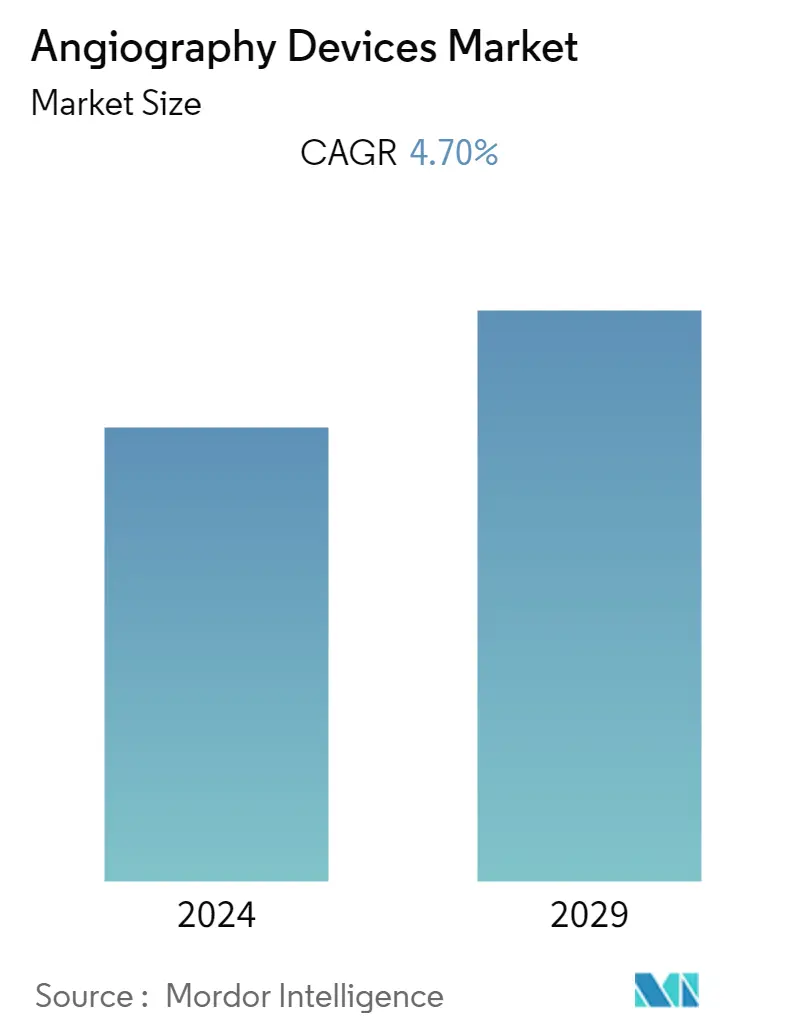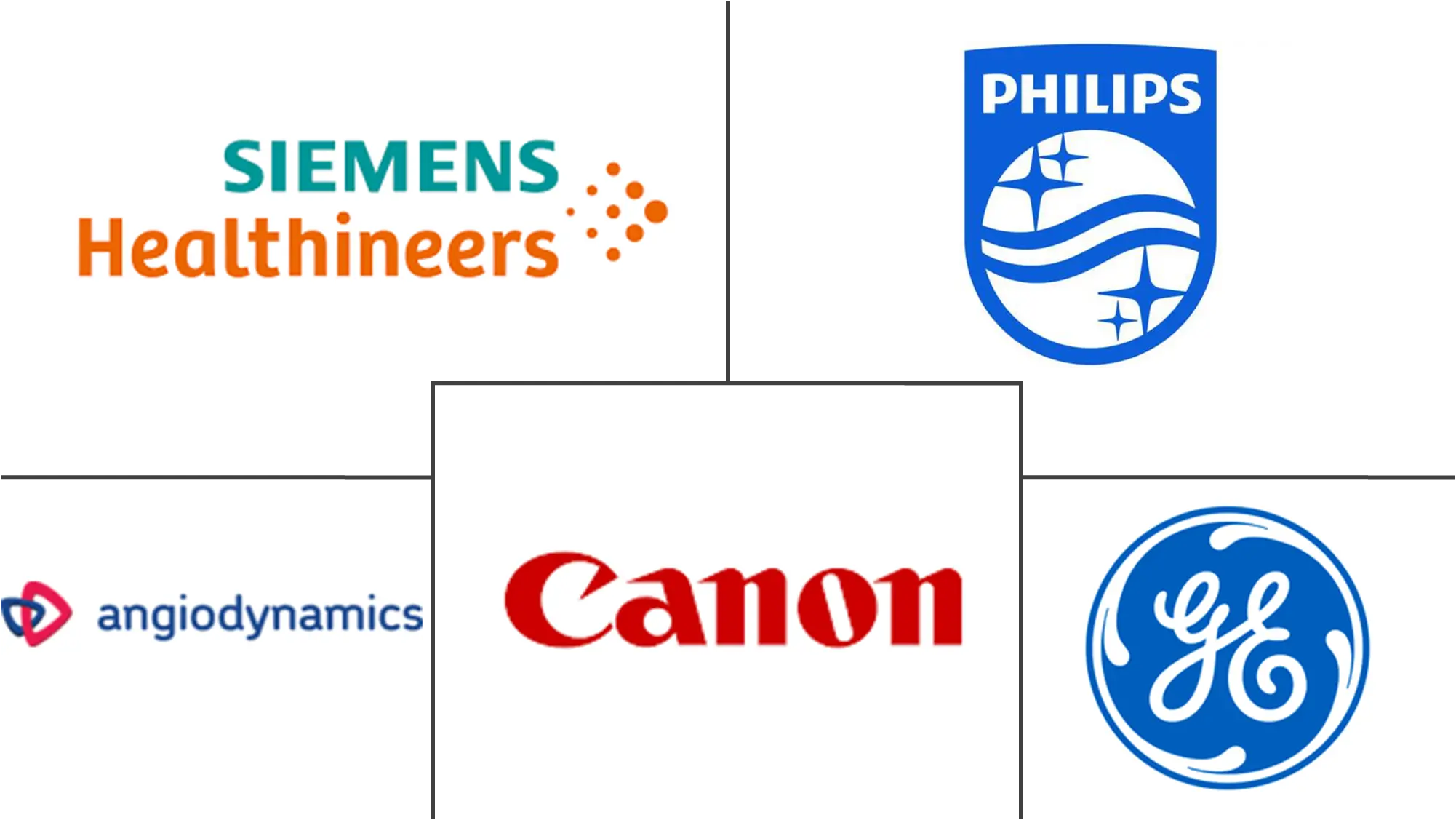Market Size of Angiography Devices Industry

| Study Period | 2019 - 2029 |
| Base Year For Estimation | 2023 |
| Forecast Data Period | 2024 - 2029 |
| CAGR | 4.70 % |
| Fastest Growing Market | Asia Pacific |
| Largest Market | North America |
Major Players
*Disclaimer: Major Players sorted in no particular order |
Angiography Devices Market Analysis
The cardiovascular diseases which include heart attacks, strokes, and other circulatory diseases have become the leading cause of premature deaths. According to the World Health Organization, 2017, cardiovascular diseases account for nearly 17.9 million deaths per year, and this number is expected to grow to more than 23.6 million by 2030. Hence, the increasing number of cardiovascular diseases is driving the demand for angiography devices, which may ultimately result in the growth of the angiography devices market. Furthermore, other factors, such as rapid technological advances, increasing awareness of the population, and a high preference for minimally invasive procedures, are supplementing the market growth.
Angiography Devices Industry Segmentation
The angiography devices covered in the market include all modalities, including equipment and consumables used during the angiographic procedures. Angiography systems utilizing various technologies, such as MRI, CT, and X-ray, are also covered in the report, along with consumables and equipment, such as catheters, guidewires, contrast media, and incision closure devices.
| By Product | |||||||
| Angiographic Systems | |||||||
|
| By Technology | |
| MRI | |
| CT | |
| X-ray | |
| Other Technologies |
| By Application | |
| Cerebral | |
| Carotid | |
| Peripheral | |
| Aortic | |
| Coronary | |
| Other Applications |
| By End User | |
| Hospitals | |
| Diagnostic Centers | |
| Ambulatory Surgical Centers |
| Geography | ||||||||
| ||||||||
| ||||||||
| ||||||||
| ||||||||
|
Angiography Devices Market Size Summary
The angiography devices market is experiencing significant growth driven by the increasing prevalence of cardiovascular diseases, which are the leading cause of premature deaths globally. The demand for these devices is further bolstered by rapid technological advancements, heightened awareness among the population, and a growing preference for minimally invasive procedures. Hospitals dominate the market due to their larger patient pools, extensive resources, and comprehensive healthcare infrastructure. The affordability and accessibility of hospitals, coupled with government funding and trade agreements with manufacturers, enhance their capacity to treat complex cardiac conditions effectively.
North America leads the angiography devices market, supported by a high adoption rate of minimally invasive procedures, robust reimbursement frameworks, and a substantial geriatric population. The region benefits from a well-established network of medical device companies and hospitals, along with favorable government support. Europe follows as the second-largest market, with its significant share attributed to the high prevalence of cardiovascular diseases, substantial government investments, and efficient product approval processes. The market is characterized by consolidation and intense competition, with a few global players, such as AngioDynamics Inc., Boston Scientific Corporation, and GE Healthcare, dominating due to their technological capabilities and ability to navigate stringent product approval processes.
Angiography Devices Market Size - Table of Contents
-
1. MARKET DYNAMICS
-
1.1 Market Overview
-
1.2 Market Drivers
-
1.2.1 Rising Geriatric Population and Increasing Prevalence of Cardiovascular Diseases
-
1.2.2 Growing Demand for Interventional Angiography in Minimally Invasive Surgeries
-
-
1.3 Market Restraints
-
1.3.1 High Procedure and Equipment Cost
-
1.3.2 Risks Associated with Angiography Procedures
-
-
1.4 Porter's Five Forces Analysis
-
1.4.1 Threat of New Entrants
-
1.4.2 Bargaining Power of Buyers/Consumers
-
1.4.3 Bargaining Power of Suppliers
-
1.4.4 Threat of Substitute Products
-
1.4.5 Intensity of Competitive Rivalry
-
-
-
2. MARKET SEGMENTATION
-
2.1 By Product
-
2.1.1 Angiographic Systems
-
2.1.2 Consumables
-
2.1.2.1 Catheters
-
2.1.2.2 Guidewires
-
2.1.2.3 Contrast Media
-
2.1.2.4 Incision Closure Devices
-
2.1.2.5 Accessories
-
-
-
2.2 By Technology
-
2.2.1 MRI
-
2.2.2 CT
-
2.2.3 X-ray
-
2.2.4 Other Technologies
-
-
2.3 By Application
-
2.3.1 Cerebral
-
2.3.2 Carotid
-
2.3.3 Peripheral
-
2.3.4 Aortic
-
2.3.5 Coronary
-
2.3.6 Other Applications
-
-
2.4 By End User
-
2.4.1 Hospitals
-
2.4.2 Diagnostic Centers
-
2.4.3 Ambulatory Surgical Centers
-
-
2.5 Geography
-
2.5.1 North America
-
2.5.1.1 United States
-
2.5.1.2 Canada
-
2.5.1.3 Mexico
-
-
2.5.2 Europe
-
2.5.2.1 Germany
-
2.5.2.2 United Kingdom
-
2.5.2.3 France
-
2.5.2.4 Italy
-
2.5.2.5 Spain
-
2.5.2.6 Rest of Europe
-
-
2.5.3 Asia-Pacific
-
2.5.3.1 China
-
2.5.3.2 Japan
-
2.5.3.3 India
-
2.5.3.4 Australia
-
2.5.3.5 South Korea
-
2.5.3.6 Rest of Asia-Pacific
-
-
2.5.4 Middle-East and Africa
-
2.5.4.1 GCC
-
2.5.4.2 South Africa
-
2.5.4.3 Rest of Middle-East and Africa
-
-
2.5.5 South America
-
2.5.5.1 Brazil
-
2.5.5.2 Argentina
-
2.5.5.3 Rest of South America
-
-
-
Angiography Devices Market Size FAQs
What is the current Angiography Devices Market size?
The Angiography Devices Market is projected to register a CAGR of 4.70% during the forecast period (2024-2029)
Who are the key players in Angiography Devices Market?
AngioDynamics Inc., Canon Medical Systems Corporation, GE Healthcare, Siemens Healthineers AG and Koninklijke Philips NV are the major companies operating in the Angiography Devices Market.

